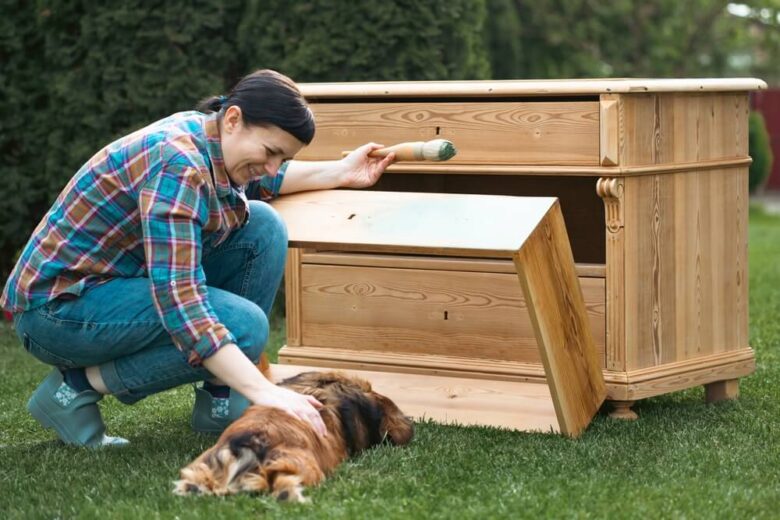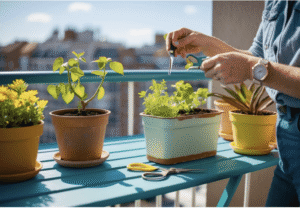Upcycling old furniture is more than a home improvement project; it’s an engaging creative journey that lets you express yourself while contributing to a more eco-friendly world. Step one in making any transformation is finding an object with potential. Thrift stores and yard sales can provide excellent opportunities to find items with strong construction but an outdated finish.
Gather Your Materials
Before beginning to transform a piece of furniture, the first step should be gathering all necessary materials. This might include paint, fabric, or stencils you plan to use—remembering to select colors that complement existing home decor! You could even consider incorporating modern design trends—for instance, adding clean lines and bold colors into rustic farmhouse pieces or modern metal elements into classic wooden tables for upcycling purposes.
Once you have your materials ready to use, it’s time to get down to work on your transformation project. Start by cleaning and sanding surfaces prior to applying paint or other adhesives; additionally, it would be wise to set up your workspace in an area that provides adequate lighting and ventilation, especially if dealing with paint or adhesives. Creative repurposing projects revitalize old furniture by transforming it into entirely new uses. For instance, you could transform an old ladder into an intriguing bookshelf or transform an old suitcase into an eye-catching coffee table.
Paint or Refinish
One of the easiest and simplest ways to upcycle furniture is with paint or stain. A fresh color can breathe life back into an outdated wooden table or dresser; alternatively, an upholstery project can transform a dull chair into something spectacular and contemporary.
Start by thoroughly cleaning and sanding the piece before beginning any new finish work. Applying a clear sealant can protect your work and avoid future damage; for beginners, chalk paint or water-based stain are great choices, as they adhere well to most surfaces without extensive prep needed for application; when painting, multiple thin coats are preferred to achieve a professional look. Researching current design trends to inspire your upcycling project. A classic wooden table can easily be modernized by adding sleek metal legs or using geometric patterns for contemporary flair in any space.
Mosaic Finish
An attractive mosaic finish can completely transform a piece of furniture. Select a design that complements your home’s aesthetic without overburdening it with too many details—this will ensure it looks professional. Choose a hue that complements your living space, and don’t be afraid to experiment with various techniques. Create ombre effects, distress the finish, or stencil patterns to showcase your imagination and showcase your creativity.
Repurposing furniture can be an immensely satisfying hobby: discovering a fresh purpose for items once considered trash or unwanted. By seeing potential in old tables, chairs, and other household furnishings that once went unused, repurposing can save resources while giving your home its own distinctive appearance. Making DIY repurposing part of your routine will allow you to explore your creative vision while turning more belongings into modern masterpieces!
Chalkboard Paint
Chalk paint transforms furniture into an easy writing and drawing surface while adding color to any room. Use chalkboard paint on household items such as jars or storage bins to label contents for easy organization. Plus, its use complements both rustic charm and modern minimalism decor styles! Plus, it can easily be cleaned using just a damp cloth!
When selecting furniture to upcycle, look for pieces with sturdy construction and intriguing details. Thrift stores, flea markets, and yard sales offer ample opportunities for finding items with potential. Once the piece is clean and sanded appropriately for its finish (paint requires less sanding than stain), start painting from the top down, avoiding drips or splashes as you work down, working your way towards the base. After it dries completely, apply a layer of wax protection—you’ll love how easily this project transforms old furniture.
Add Hardware
Add or replace hardware on any piece of furniture for an instant facelift, whether it’s cabinets, drawers, desks, dressers, or tables—whether they be cabinets, drawers, desks, dressers, or tables! By swapping out old knobs with more contemporary ones, you can give any piece a completely different style and make any existing holes disappear altogether—often filling them in first may be required, so be mindful when starting.
Upcycling furniture can be an enjoyable and creative journey that pays dividends in sustainability, cost-efficiency, and the creation of one-of-a-kind pieces to fit any decor style—if that ugly dresser in the thrift store looks promising, then don’t discount its potential! Good luck crafting, and have fun upcycling!
Embrace the Imperfections
Attaining perfection may be impossible, but accepting imperfections in an upcycled project is an incredible way to express your creativity. For instance, scratched coffee tables can be transformed with decals placed over their scratched surfaces; this method is simple and perfect for DIYers looking for ways to customize the piece themselves.
Accepting imperfections in upcycled furniture can also be an excellent way to give back to the environment. Too often, old furniture ends up in landfills where it creates environmental harm; by recycling this furniture instead, you are helping reduce waste while creating unique pieces for your home.
Upcycling can be an enjoyable and creative journey that allows you to transform everyday household items into stunning modern masterpieces. Start small to familiarize yourself with the process. As soon as you’ve gotten comfortable, begin exploring various styles and materials until you create your very own upcycled masterpiece!




